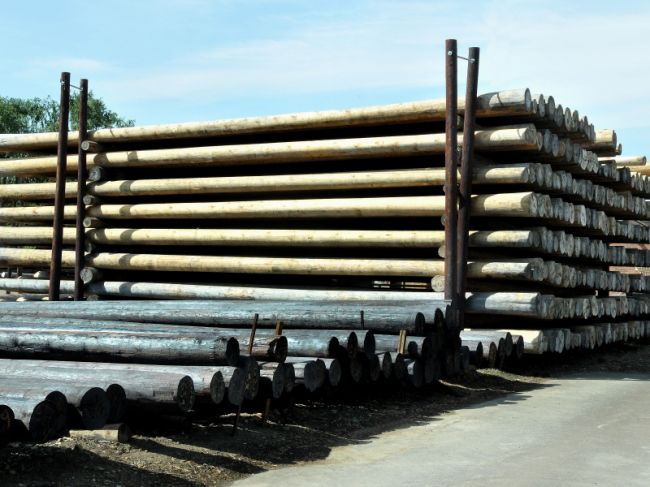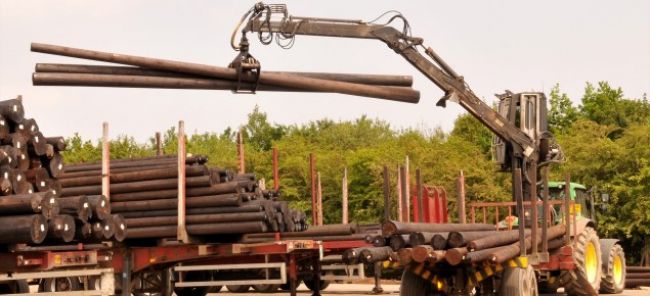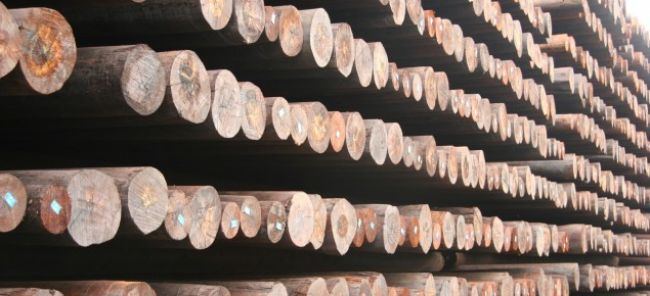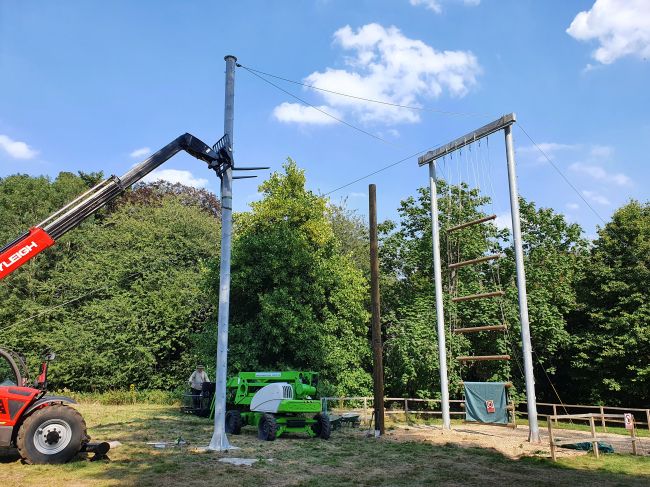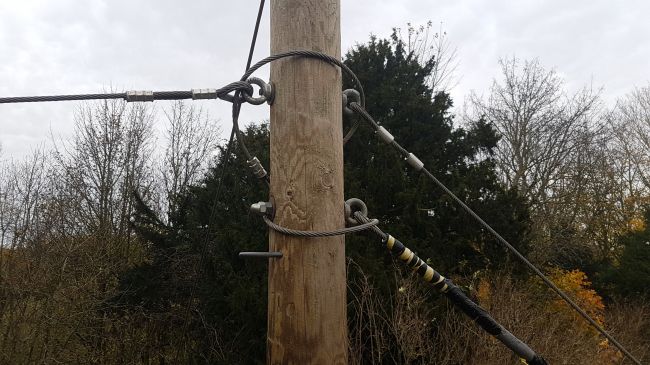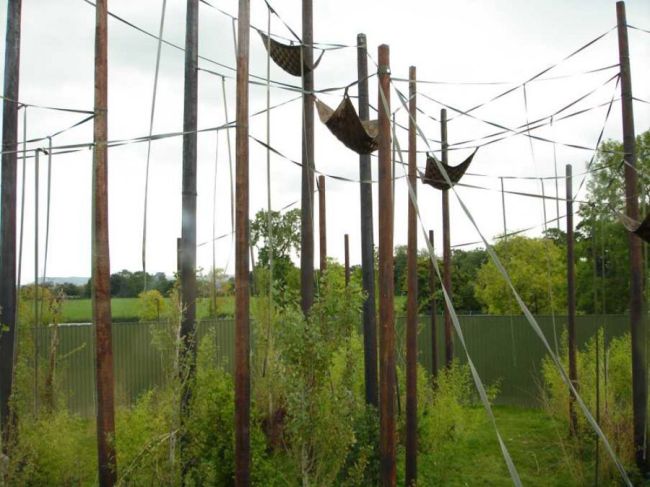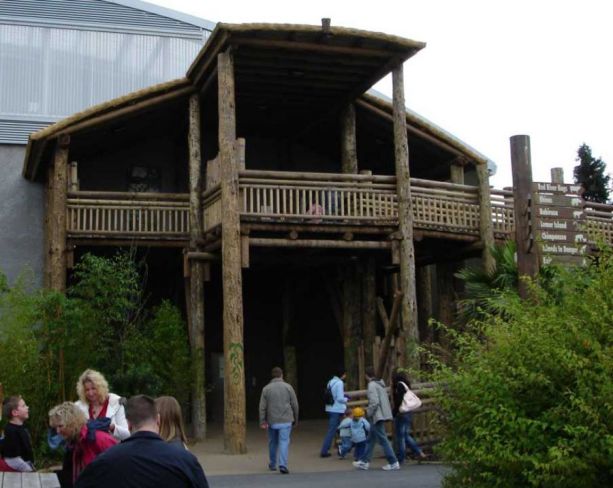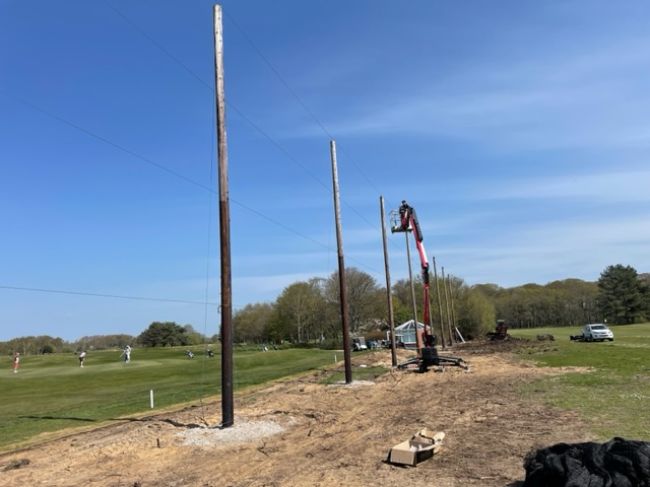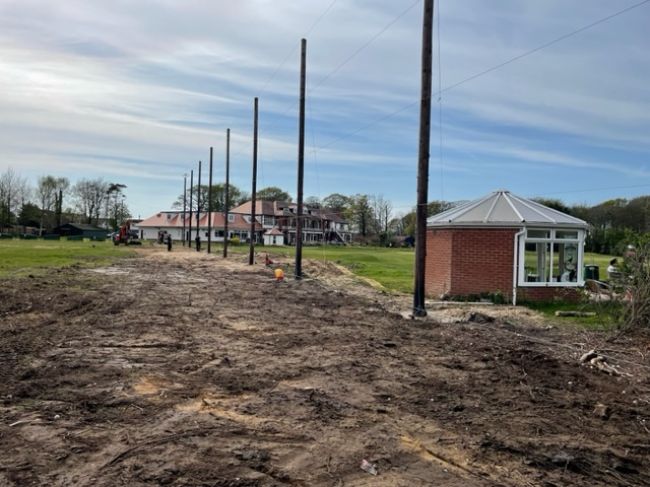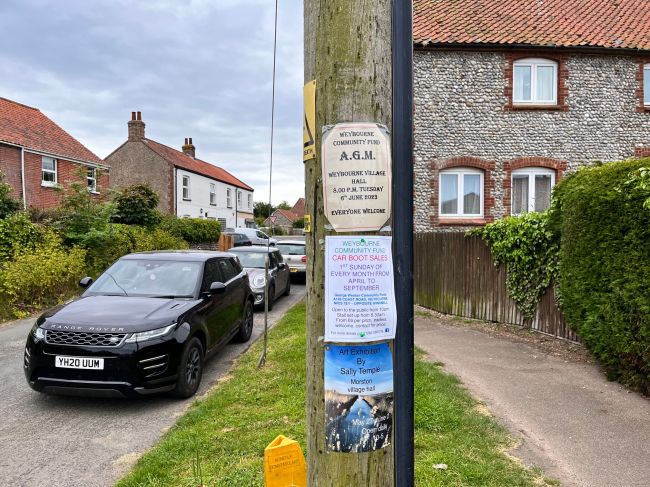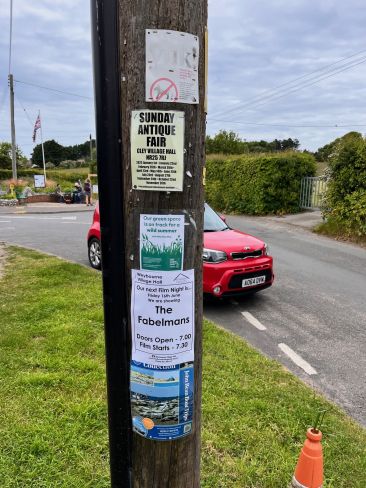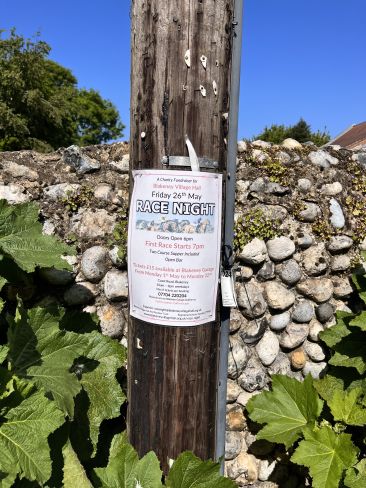Ordering
Overview
The widespread use of new wooden telegraph poles
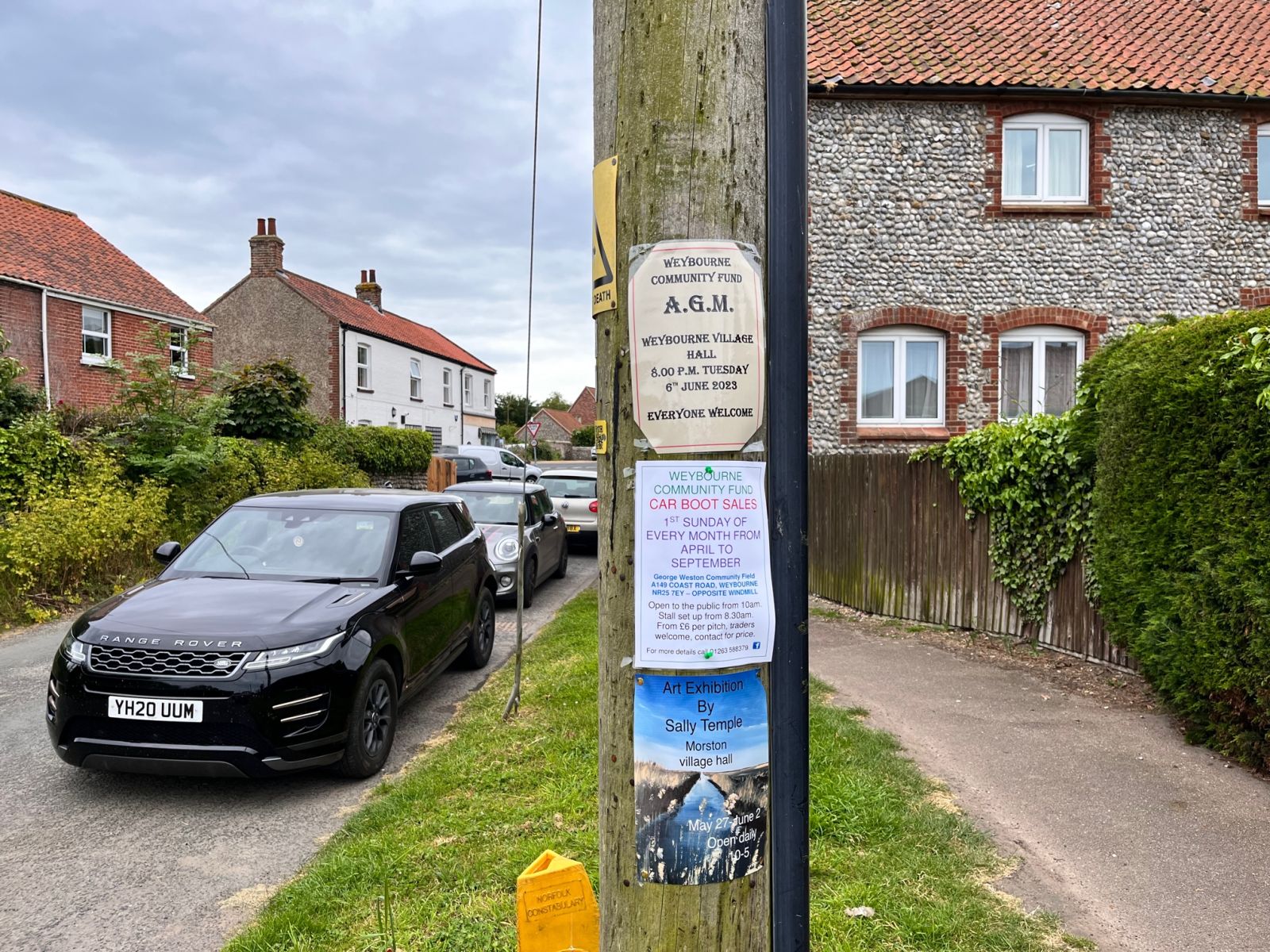
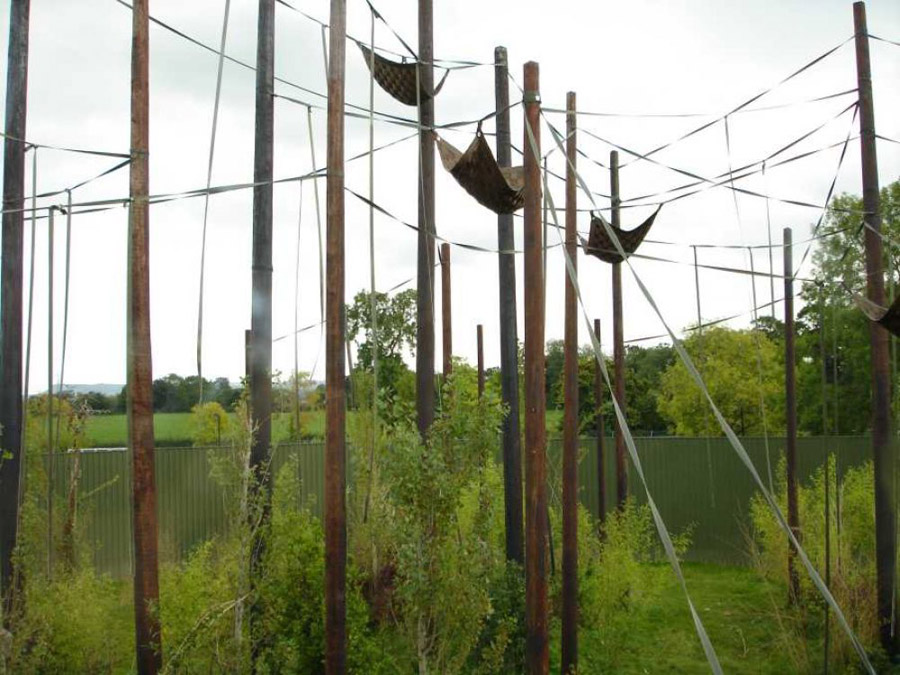 Wooden telegraph poles are part of the fabric of British scenery, and can be seen in most villages and towns throughout the UK. Over the last hundred years they have supported a spider web of overhead telephone lines and power cables that span across our countryside. Doubling up as notice boards, there are thousands of lost dog signs, village fete posters and council proclamations conveniently pinned to their bases. Due to their versatility, wooden telegraph poles are increasingly appearing in construction, landscaping and leisure projects:
Wooden telegraph poles are part of the fabric of British scenery, and can be seen in most villages and towns throughout the UK. Over the last hundred years they have supported a spider web of overhead telephone lines and power cables that span across our countryside. Doubling up as notice boards, there are thousands of lost dog signs, village fete posters and council proclamations conveniently pinned to their bases. Due to their versatility, wooden telegraph poles are increasingly appearing in construction, landscaping and leisure projects:
~ roof supports ~ bridges & walkways ~ architectural columns ~ edging & retaining ~ river embankments ~ marinas & moorings ~ platforms & decking ~ gate posts & fencing ~ adventure play areas ~ forest walkways ~ treehouses ~ boat masts ~ shade sails ~ pole barns etc.. The list is endless!
General information about our new telegraph poles
TYPE OF WOOD. Normally our telegraph poles are made from Redwood or Scots Pine (Pinus Sylvestris). All of our poles are from trees harvested from sustainably managed forests.
BRITISH STANDARD. All our Telegraph poles adher to BS 1990: Part 1, 1984, Wood poles for overhead power and telecommunication lines, Part 1. Specification for softwood poles.
Published Date: 28/09/1984
FROM THE VERY BEGINNING. After harvesting, the bark is taken off our telegraph poles and they are graded into sizes (light, medium and stout) and stacked for seasoning. Telegraph poles are dried naturally by air. This process begins when first harvested and continues once they have been shipped to the UK, where they are moisture tested again and laid out for further seasoning. They are left for up to twelve months to complete the natural drying process. During this time telegraph poles are consistently moisture tested, and are not pressure treated until their moisture content is below 28%.
DRESSING. In order to provide a smooth surface to all the telegraph poles, they are dressed - peeling the outer cambium layer with an automatic dressing machine.
TREATMENT. Your telegraph poles can be treated with one of two treatments:
1) AC500 Treatment is a non-creosote, environmentally friendly, water based pressure treatment similar to Tanalith E treatment. AC500 treated telegraph poles can be used for standard telegraph pole purposes, and in addition CAN be used for children's play areas, tree houses, inside houses etc.. where creosote treated telegraph poles cannot be used, due to recent creosote legislation. AC500 treated telegraph poles do not emit anything in the heat of the summer, whereas creosote treated telegraph poles may bleed or leak sticky creosote when it's hot, with nothing you can do to prevent it. AC500 treated telegraph poles are sometimes used by local authorities who have an environmental policy against creosote.
2) Creosote Treatment gives your timber telegraph pole the longest life span possible and protection from harsh conditions. Pressure treated creosoted telegraph poles provide a minimum desired service life of thirty years, but may last considerably longer. Indeed there are numerous examples of telegraph poles in service which are over 100 years old! Creosote has been used for over 150 years to preserve and increase the life-span of timber. Recent findings have indicated that creosote can be harmful in certain situations, so, be careful. Handle with gloves. Wear a dust mask when sawing or machining. Dispose of off-cuts, sawdust etc.. safely. Waste wood may be disposed of by burning, subject to any local rules on burning creosoted material in the open, or via your local waste disposal facility. Creosoted timber should not be used where there is risk of frequent (i.e. often-occurring or constant) skin contact, nor where it may come into contact with or contaminate animal or human foodstuffs. In particular it should not be used inside buildings, in playgrounds, or for garden furniture and picnic tables. For further information on creosote visit WOOD TREATMENTS
FIXING IN GROUND. Timber telegraph poles can be placed directly into the ground, and generally do not require concrete foundations or collars to prevent deterioration. Typically, a 9m pole will be inserted between 1 - 2 metres into the ground, depending on ground conditions.
CUTTING. You can cut telegraph poles to size with a chainsaw, circular saw or even a handsaw if you are feeling energetic!
SIZE, DIAMETER etc... Telegraph poles vary in length, weight, diameter and taper. Not only is every pole different in dimensions from each other (like each tree) but also they are tapered along the length. So the diameter of a new telegraph pole will vary from top to bottom. In addition the very end of the pole (the original base of the tree) can broaden out even more. So, if you are looking for absolute regularity and identical telegraph poles, forget it! We classify new telegraph poles into broadly 3 diameter ranges - 'Light' , 'medium' and 'stout'. The following table has the diameter ranges of some of our most common sizes. For further information on weight and strength specifications, see the larger table AT THE BOTTOM OF THE PAGE
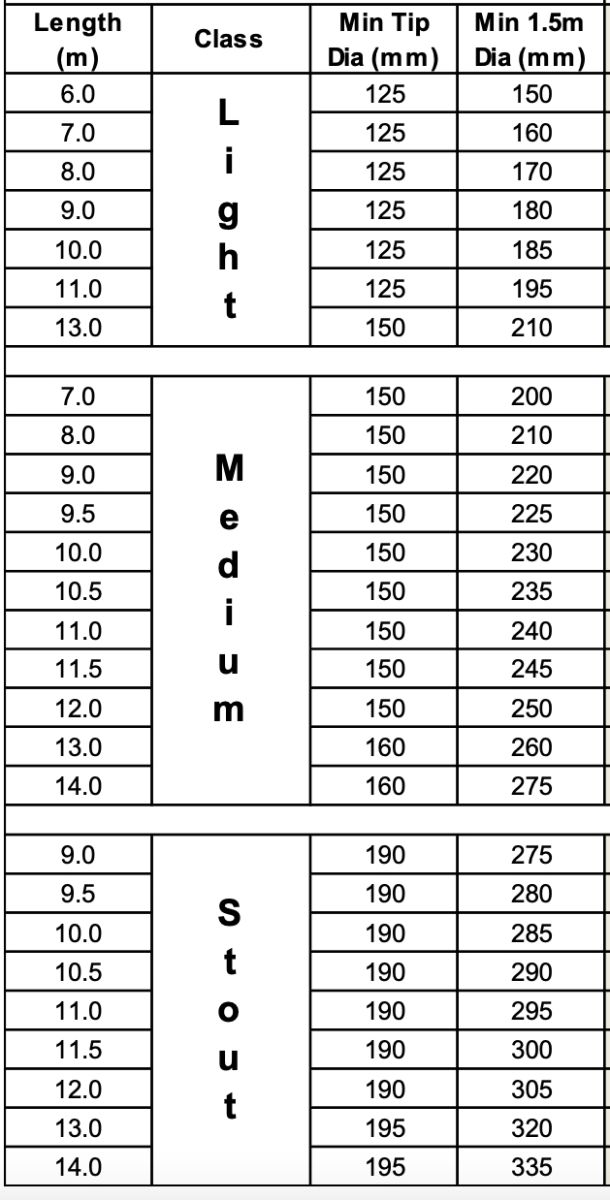 What is the difference between a telegraph pole and a landscaping pole?
What is the difference between a telegraph pole and a landscaping pole?
The most obvious one, is that a telegraph pole is generally tapered, longer in length, wider in diameter & with a choice of treatments. In contrast, a landscaping pole is untapered, with a maximum length of 6.0m, and has a choice of diameter from 50mm - 200mm. See Landscaping Poles sizes and prices. So, if you are looking for height, strength & longevity, then telegraph poles would be best, whereas landscaping poles would win where you seek regularity, identical dimensions & shorter lengths.
Are you a lover of wooden telegraph poles? 
YES! There is a genuine Telegraph Pole Appreciation Society that has featured our website, and is a wonderful blend of information and eccentricity, including 'Telegraph pole of the month'. Pay them a visit! http://www.telegraphpoleappreciationsociety.org. There are some wonderful features and photos including a superb technical article about the telegraph pole, written by the Institution of Post Office Electrical Engineers in 1930.
In a recent trecking adventure we came across Hamelin Pool Telegraph Station (1884) near Shark Bay in Western Australia that shared a similar sense of telegraph pole fanaticism, eccentricity and nudity! SEE PROJECT LINK. We recently sent details off to Martin, who is a High Priest or Archbishop of the telegraph pole world, and who replied:
I can’t believe how long it’s taken me to get this post up on to the website. Jerry Deacon, who sent this to me, can’t believe how long it’s taken either. And Jerry, I’ve just realised is none other than (previously plugged on here) Kilgraney Railway Sleepers (now railwaysleepers.com) – the place to go for old railway sleepers (the clue is in the name) but also old and new telegraph poles for ornamental and nerdic use. Nice plug for you there Jerry; I trust that this is adequate recompense for my tardiness.
Anyway, back in March. Jerry wrote to tell us that as an intrepid explorer he came across Hamelin Pool Telegraph Station (1884) near Shark Bay in Western Australia. There is a definite passion for telegraph poles in Oz. In October 1872 the Overland Telegraph line between Darwin and Adelaide was completed, and the Australian telegraph network became linked directly to Europe (termite attacks notwithstanding). Hamelin station was established as a repeater station that linked Western Australia into this same network. And this is the last of these stations still extant. Now, for some reason, it features, quite prominently, a nude linesman attending to the pole top apparatus. Why this should be is anyone’s guess and Jerry offers no explanation, nor does anything at the station itself. Though he did suggest 'Nude Pole of the Month' as a possible new feature for these very pages, I’m going to pretend he never said that.
Martin Evans,
Membership no. 0001
www.telegraphpoleappreciationsociety.org
Telegraph poles & the expression 'Heard it On the grapevine'
 Telegraph poles and grapevines
Telegraph poles and grapevines
An answer to the burning question as to how "grape-vine" came to be used figuratively to mean "an informal person-to-person means of circulating information or gossip"
This originates in the USA. In the early days of telegraphy, companies rushed to put up telegraph poles, some made none too well and some actually using trees rather than poles. To some, the tangled wires resembled the wild vines found in California, hence a Grapevine. During the US Civil War the telegraph was used extensively, but the messages were sometime unreliable, hence the association of rumour on the grapevine. The phrase first appeared in print in 1852.
Another reference states:. “…grapevines were associated with telegraph lines somewhere along the line, for by the time of the Civil war a report by ‘grapevine telegraph’ was common slang for a rumor. The idea behind the expression is probably not rumors sent over real telegraph lines, but the telegraphic speed with which rumor mongers can transmit canards with their own rude mouth-to-mouth telegraph system.”
From the “Encyclopedia of Word and Phrase Origins” by Robert Hendrickson (Facts on File, New York, 1997).
VOTE OF CONFIDENCE!
Please help us spread the word! If you've found our website helpful or inspiring please leave feedback or 'Like us' on Facebook, Instagram or Twitter. A simple way of letting people know "This is a really useful website!" Thanks



TELEGRAPH POLE SPECIFICATIONS (VOLUME, SIZE, WEIGHT & STRENGTH)
SPECIFICATIONS of LIGHT DIAMETER TELEGRAPH POLES |
|||||||
|
Length (metres) |
BASE min diameter (mm) 1.5m from Butt |
TOP min diameter (mm) |
Gefle Cu |
Caliper Cu M3 |
Creo weight (Kilo) |
Ultimate load @0.6m from top of pole (kN) |
Load per mm deflection at point of application of load(N) |
|
6 |
150 |
125 |
3.0 |
0.1099 |
76 |
4.39 |
9.3 |
|
7 |
160 |
125 |
4.0 |
0.1288 |
108 |
4.31 |
6.0 |
|
8 |
170 |
125 |
5.0 |
0.1985 |
126 |
4.4 |
4.8 |
|
|
|||||||
|
9 |
180 |
125 |
6.0 |
0.2251 |
168 |
4.46 |
3.6 |
|
|
|||||||
|
10 |
185 |
125 |
7.25 |
0.2699 |
190 |
4.25 |
2.8 |
|
|
|||||||
|
11 |
195 |
125 |
8.5 |
0.3200 |
230 |
4.4 |
2.3 |
|
|
|||||||
|
12 |
200 |
125 |
9.5 |
0.3922 |
272 |
4.26 |
1.7 |
|
13 |
210 |
130 |
10.5 |
0.4366 |
288 |
4.46 |
1.6 |
SPECIFICATIONS of MEDIUM DIAMETER TELEGRAPH POLES |
|||||||
|
Length (metres) |
BASE min diameter (mm) 1.5m from Butt |
Top min diameter (mm) |
Gefle Cu |
Caliper Cu M3 |
Creo weight (Kilo) |
Ultimate load @0.6m from top of pole (kN) |
Load per mm deflection at point of application of load (N) |
|
8 |
215 |
150 |
8.0 |
0.2919 |
203 |
8.2 |
9.1 |
|
9 |
220 |
150 |
9.0 |
0.3149 |
217 |
8.15 |
7.8 |
|
|
|||||||
|
10 |
230 |
150 |
10.5 |
0.3599 |
254 |
8.15 |
6.4 |
|
|
|||||||
|
11 |
240 |
150 |
12.50 |
0.4298 |
293 |
8.18 |
5.0 |
|
|
|||||||
|
12 |
250 |
150 |
15.5 |
0.4899 |
345 |
8.23 |
4.1 |
|
13 |
260 |
160 |
17.00 |
0.5760 |
376 |
8.46 |
3.7 |
|
14 |
275 |
160 |
21.00 |
0.6434 |
432 |
8.98 |
3.3 |
|
15 |
290 |
165 |
24.00 |
0.7651 |
532 |
9.6 |
3.3 |
|
16 |
305 |
170 |
26.50 |
0.8688 |
591 |
10.23 |
3.1 |
|
17 |
320 |
180 |
30.00 |
0.9951 |
676 |
11.07 |
3.0 |
|
18 |
330 |
180 |
35.00 |
1.1482 |
771 |
11.14 |
2.7 |
|
20 |
360 |
180 |
46.00 |
1.3787 |
954 |
11.98 |
2.5 |
|
22 |
380 |
180 |
54.00 |
------- |
---- |
12.63 |
2.3 |
SPECIFICATIONS of STOUT DIAMETER TELEGRAPH POLES |
|||||||
|
Length (metres) |
BASE min diameter (mm) 1.5m from Butt |
Top min diameter (mm) |
Gefle Cu |
Caliper Cu M3 |
Creo weight (Kilo) |
Ultimate load @0.6m from top of pole (kN) |
Load per mm deflection at point of application of load (N) |
|
|
|||||||
|
9 |
275 |
190 |
13.00 |
0.4630 |
319 |
15.91 |
19.2 |
|
|
|||||||
|
10 |
285 |
190 |
16.00 |
0.5502 |
378 |
15.52 |
15.5 |
|
|
|||||||
|
11 |
295 |
190 |
19.00 |
0.6533 |
443 |
15.24 |
11.8 |
|
|
|||||||
|
12 |
305 |
190 |
22.00 |
0.7428 |
515 |
15.08 |
9.4 |
|
13 |
320 |
195 |
25.00 |
0.8280 |
571 |
15.73 |
8.3 |
|
14 |
335 |
195 |
28.00 |
0.9485 |
633 |
16.24 |
7.3 |
|
15 |
350 |
195 |
33.00 |
1.0565 |
734 |
16.68 |
6.8 |
|
16 |
365 |
200 |
36.00 |
1.1737 |
788 |
17.35 |
6.2 |
|
17 |
375 |
200 |
40.00 |
1.3167 |
843 |
17.20 |
5.4 |
|
18 |
390 |
200 |
47.00 |
1.5362 |
1120 |
17.51 |
5.0 |
|
20 |
415 |
200 |
60.00 |
1.8516 |
1260 |
17.74 |
4.2 |
|
22 |
435 |
200 |
72.00 |
2.0388 |
1419 |
17.49 |
3.6 |
|
24 |
470 |
200 |
89.00 |
------- |
----- |
18.36 |
3.3 |
|
The strength properties stated here are based on using unstayed poles (Cantilevers) |
|||||||
Extra Info
TELEGRAPH POLES ARE DELIVERY BY AN ARTIC LORRY WITH CRANE OFFLOAD
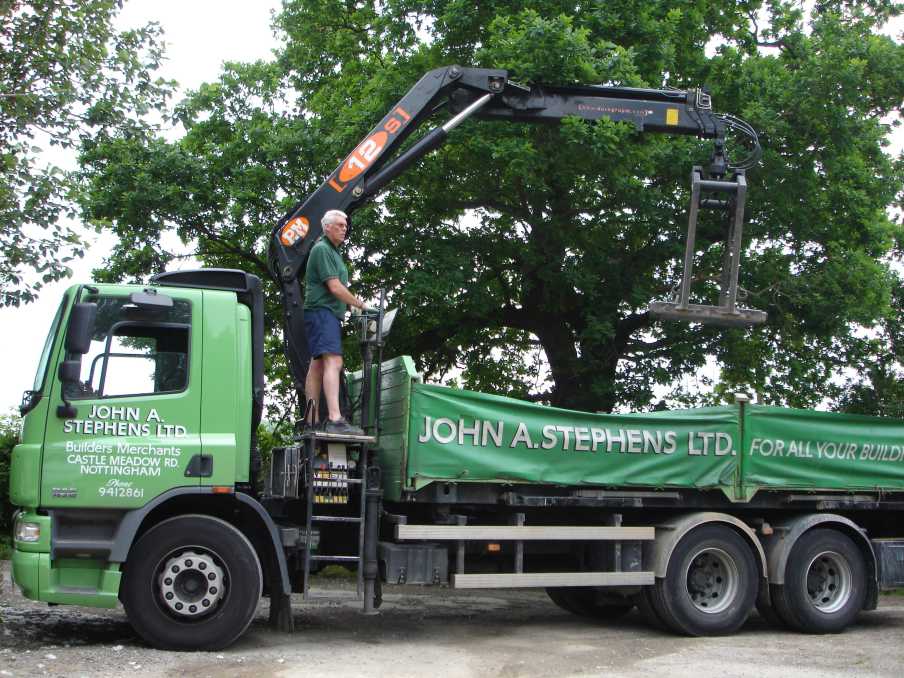
Our specialist telegraph pole lorries can offload themselves with a hiab crane. Your order can be crane-offloaded so long as there is space for the artic crane to operate without lifting over vehicles etc..You must ensure in advance that there is sufficient access space for the lorry to approach, manoevre and park. We will send you an artic access questionnaire, with all the required access space dimensions, to fill in before the delivery.

